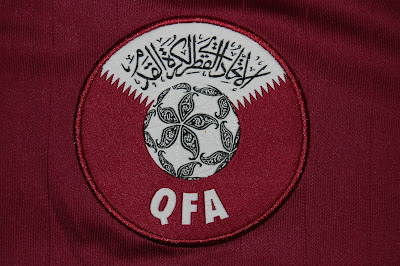Home 2008-10; Burrda.
Qatar and football didn’t really go hand in hand for most
people until recently, which isn’t really surprising. The game was only brought to the Arab nation
in the late 1940s, when foreign workers arrived to seek their fortune in the
oil-fields there. There were attempts at
setting up a governing body to oversee competitions but it wasn’t until 1960
that the F.A. was founded formally. A league came into being soon after, but
the Qatari F.A. only became affiliated to FIFA in the early 1970s, almost ten years
after the first Qatari national league was set up. So after a decade of league seasons, the
first official league season didn’t
kick-off until 1973.
Since then, Qatar's involvement in international
football has been somewhat controversial at times. Firstly, the liberal use of naturalisation
rules has led many foreign born players being fast-tracked to full citizenship
in order to play for the national team.
While this is not isolated to Qatar, it is more glaring in this instance
due to the strict conditions for citizenship that are flouted, in comparison to
a “normal” foreigner who lives in Qatar.
Also, in other countries, such as Ireland, it is the “grand-parent rule”
that is usually taken advantage of the get a foreign born player on the books. In Qatar, little or none of these players had
a connection to the country before moving to play club football there. It should be noted, that the wider Gulf
region is experiencing a similar development.
The major controversy however, is the awarding of the 2020
World Cup to the country. There has been
numerous accusations of corruption in the awarding process. In simple terms, it would seem that Qatar is
not suited to hosting such a tournament due to political, climatic,
environmental, human rights and social justice reasons (it would be easy to add
in their lack of international football pedigree, but I personally don’t think
that is an issue in hosting a good World Cup).
On the other hand, they have an awful lot of money. FIFA seem to like money. FIFA have awarded Qatar the tournament. Not exactly difficult to see why the
conspiracy theories took hold.
Qatar’s only success to date comes in the form of Gulf Cup wins in 1992 and 2004; and they took
gold as hosts at the 2006 Asian Games.
The 1980s were something of a golden period for the team, setting and
equalling their ‘biggest win’ records of 8-0 against Afghanistan and Lebanon
respectively. The u-20 team famously
reached the 1981 Youth World Cup final against Germany, having taken care of
Brazil and England en route. Three years later Qatar qualified for their debut
Olympics appearance.
Turning to towards the shirt, it is unique I believe in being the only maroon home shirt in international football. The away version flips the colours and looks really nice too, but I just had to go for this one. It is made by Swiss company ‘Burrda’, who have made some recent moves in boosting their profile in football and rugby across Europe. Most notably in international terms is their taking over from Nike as suppliers to the Belgian national team, and they also supply Tunisia. This shirt features a nifty pin-stripe styling, as well as a nice ‘old-school’ floppy collar. While the Burrda logo is a bit strange, there is no denying that the Qatar FA’s crest is one of the best around. It makes great use of the national flag, with some very impressive looking Arabic writing. Not being an Arabic speaker, I’ve tried to research what it says but have failed apart from an unconfirmed suggestion that it simple says “Qatar Football Association”. If anyone can help, please feel free to contact me. In the centre, is a rather snazzy football design that you can see in the pictures below. All in all, in an age where many Fas are getting in graphic designers to butcher traditional crests and logos, there is something strangely reassuring about Qatar’s.
As a point of interest, I will add a very small piece of
Qatari history here that I was not aware of until putting together this post. In 1995, the then the Emir of Qatar, Sheikh
Khalifa bin Hamad al-Thani, went on a little trip to Switzerland. He left his son, Crown Prince Sheikh Hamad
bin Khalifa al-Thani, in charge of running the place while he was away. The only fly in the ointment was that the
Crown Prince was ready to oust his father in a coup, and he struck during his
father’s absence and claimed the throne with the support of the majority of the
rest of the family. Snr claimed at the
time that he would return and claim it back, but when other nations, including
the USA, began to recognise the new Emir as the legitimate ruler, the game was
up. He has since returned, but I imagine
Sunday dinner remains awkward.












No comments:
Post a Comment